The Willy Wonka wool room
OK, so when I wrote last week about how Donegal yarn is spun, I left out the best bit.
It was deliberate, as I thought this process deserved a post on its own.
When Maureen at Donegal Yarns started our tour of the factory, she said she had taken a school party around recently. And one of the children had been so impressed, that they said it was like Willy Wonka’s chocolate factory.
We smiled politely of course. But in my head I was thinking, there’s no way this is going to be that impressive. I’ve seen factories before. Those kids were too impressionable.
Then we went to the mixing room (below). Even the name sounds like something out of Willy Wonka. In fact, it was probably called something else, but that’s what I remember.
It looked like a fairly ordinary room, with a pile of coloured fleeces at the bottom. To be honest it looked a little bit grubby. My expectations were not raised.
Then it started snowing wool.
Slowly at first. Pieces of the coloured fleece started drifting down lazily from the ceiling. We looked inside, and saw there was a rotating double-ended pipe up there, spinning gently, with pieces of the wool coming out from either end. Well this is nice, we thought. Beautiful even.
Then it span faster, emitting larger clumps of wool. Then faster still. And again faster, until from the outside all you could see was a blizzard of red, white, ochre and black.
At this point, Maureen said I could go in. Like Augustus Gloop being told he could swim in the chocolate river. OK, not quite as good; but still, slightly surreal.
Apparently you can’t really contaminate the wool, as it will be washed thoroughly later. In fact after it’s been mixed together here, it's sucked through pipes in the floor, and spat out into a baling machine on the other side side of the corridor.
More echoes of Willy Wonka. I wonder if misbehaving staff ever get sucked down the tube as punishment, and sent back to their parents, never to inherit the factory.
After I had danced like an idiot in the blizzard of wool, and Jamie had taken enough photos of me doing so, I was hosed down outside.
Not, I was pleased to find, with water. That would not be a good idea in a building covered with wisps of animal fibre. Everything would get stuck to it.
Instead an air hose is used to blow all the wool off - and indeed is used on machinery to do the same.
We then asked the questions we should have done at the start, like how this process works and why it is used.
Apparently it’s a pretty efficient way to mix all the wool together. There are often large volumes, and as we covered in our previous piece on Donegal Yarns, there are both lots of colours and two distinct types - one that makes up the body of the fabric, and another that creates the flecks.
Those have to be thoroughly mixed, otherwise you’ll end up with cloth that has noticeably more of one colour in one part of the material than another.
It has to look random, but not be random. Like a random-number generator, which never feels random if numbers repeat. Or early iPods, which were apparently changed so the shuffle function didn’t play songs that were near each other. Because that felt more random.
That’s probably one tangent too many. Let’s just quickly round off the production process.
The mixed wool gets stuffed into bales, like the ones above. Those are then used to feed the carding machines, before that's washed and spun. Those stages are all spelt out in our previous article on Donegal Yarns.
I never actually saw what that mix of black, ochre, red and white got turned into. But going on what I’ve seen before from Donegal tweed, it will probably be surprisingly subtle. I’ll see if I can track down a picture of the cloth for a future article.
Photography: Jamie Ferguson @jkf_man
DonegalYarns.com


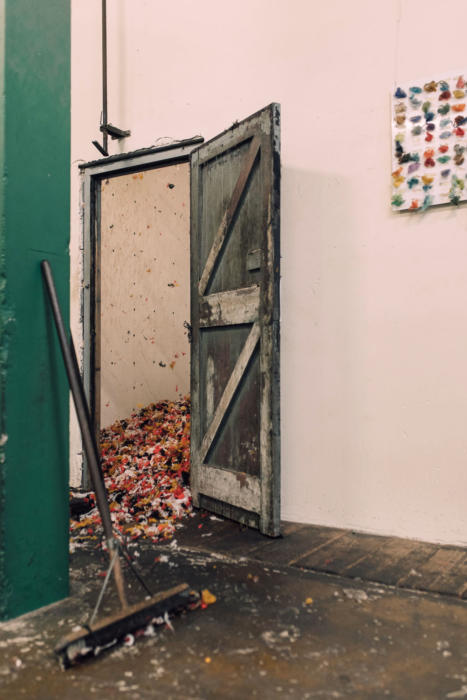
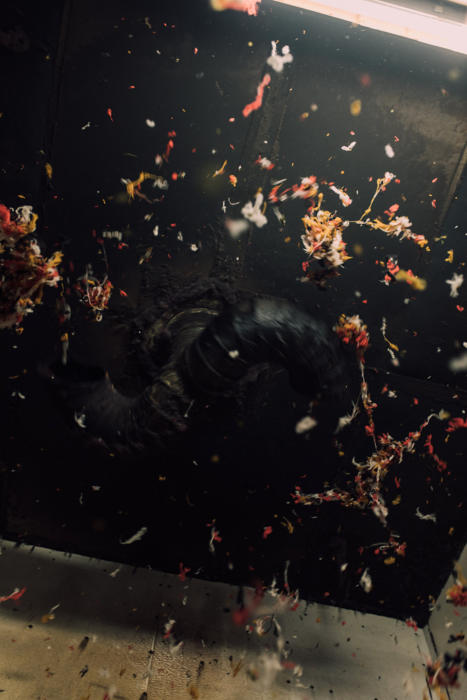
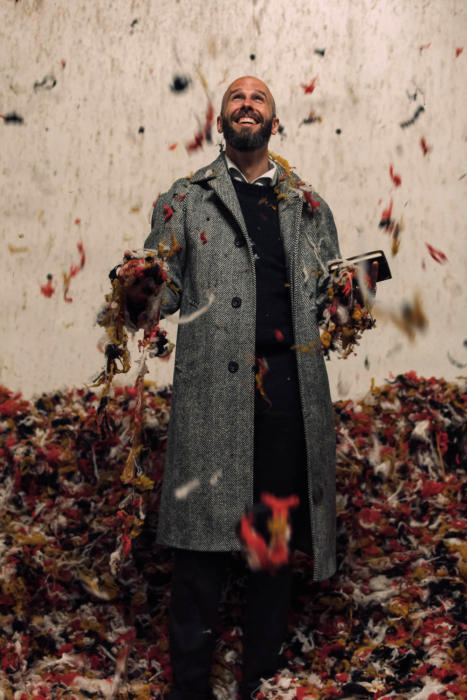
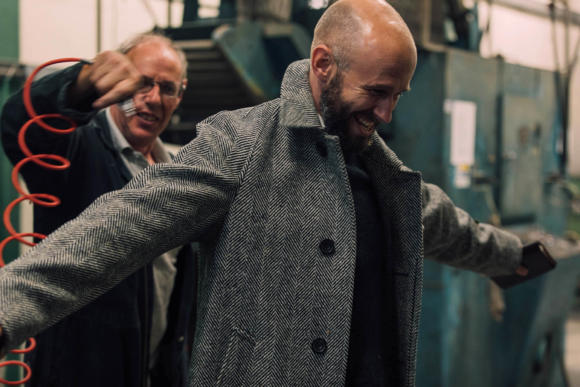
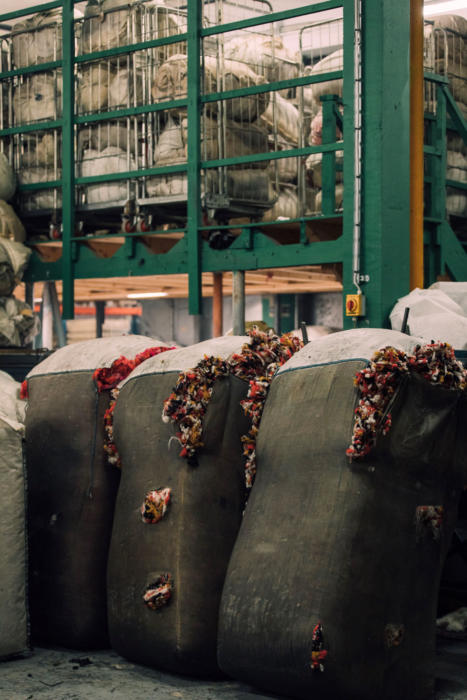
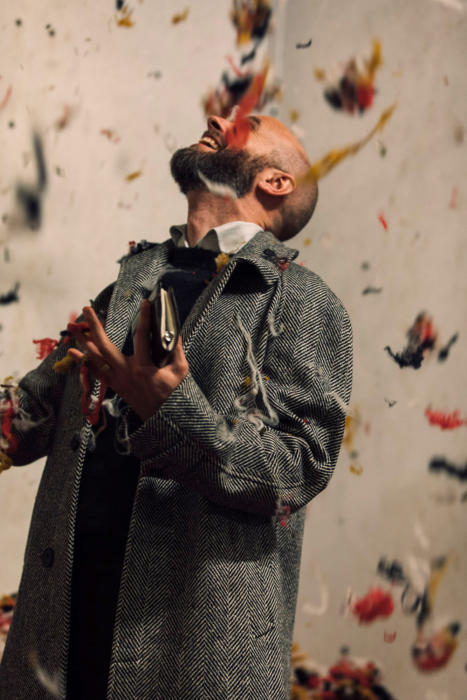


























Funny little piece, thank you for sharing Simon. Seems like you’ve hat quite some fun!
Don’t know why this reminds me of this, but when I was a student I earned money in the summer working for the British Wool Marketing Board in Bradford. It was a huge warehouse that received whole fleeces from farmers, and they were raided into around a hundred different types and qualities, and press packed into quarter ton bales.
Every week buyers came from around the world to participate in an auction, a lot of money changed hands, and we could earn really good money, albeit on brutally hard piece work, but at the end of the summer I was as fit as a flea, ready for preseason soccer training!
BWMB had a number of initiatives to broaden use for British wool, which generally isn’t suitable for suiting etc. They had a caravan which went round the agricultural shows selling cloth, military style jumpers etc – everything was bomb proof, the polar opposite of super 100s and cashmere!
A perk for the workers was that you might get to drive the van at the weekend to restock the caravan, up in Scotland, or wherever. More good money, especially if you slept in the back of the van and kept the overnight allowance.
Worst job was dealing with daggings, essentially the woolly clinkers from the rear of the fleece, which the farmers sent in separate bags. They had to be laid out to dry, or they would catch fire, and then packed into bales by jumping up and down on them!
It was a thriving industry, now most fleeces aren’t even worthwhat it costs to get the sheep sheared!
Wonderful.
Do you think you appreciate wool more, today, having had that experience? Or can you not stand the sight of it?
I love it.
I live in the Yorkshire Dales, and can still pretty much identify breeds of sheep in the field from my experience of handling their fleeces. The graders had a five year apprentice ship, and because it war seasonal, and such hard work, a number of them went climbing and mountaineering in the winter.
Wonderful
Love this Simon. Just the photos alone are really enjoyable!
Looks fabulous. Can I book it for my son’s birthday party?
Fascinating insight into the process. Just reading back over the previous article again, someone mentioned in the comments that from a distance the colours look muted but when up close you can see that there are actually very bright colours and flecks.
It reminds me of a field of heathers which can look quite sombre from a distance but when you walk amongst it you realise that the colours are actually bright and varied.
Good point Con. And of course, reflecting the scenery like that has always been a part of tweed design
All slightly bonkers and very clever at the same time. What an amazing process, to create something with such depth and subtlety.
Thoroughly enjoyed this one. Your enthusiasm is contagious. I imagine this particular mix turned into a really nice midbrown – maybe a bit like the brown version of your escorial but a bit more tweedy!
Great pic’s, good to see you don’t take your self seriously
I try very seriously not to
So it’s pretty much menswear heaven.
Lovely.
A golden ticket in a PS Oxford?
Quintessential PS. A lovely article.
Which shirt and sweater are you wearing under your beautiful coat ?
It’s a pale-grey brushed cotton from Marol, and a charcoal hand-framed knit from Dalmo.
Not the easiest to wear together, as the shirt has immense friction. But very cosy
Hi Simon. The opening sentence appears to have text that looks different to the rest of the article, but it isn’t a clickable link, is it supposed to go to the original Donegal article?
Yes it is, that’s odd. I seemed to have fixed it now. Do let me know if it still doesn’t work for you
As an aside but related to this delightful article – in the Van Gogh museum in Amsterdam, on the second floor, there is a small exhibit with a wodden box of yarn fragments that Van Gogh collected. and kept with him. The yarns are bits and pieces of amazingly intense colors. Apparently he collected these colors to inspire him with his paint colors. It is a very human touch, relatable to all of us. The intensity of the dyes obviously translated into the oil colors of his paintings.
It would be interesting to see details of the yarns in the Willy Wonker room and to know the origins of the dyes and colors as well as the origins of the phrase “dyed in the wool” meaning unchangeable.
Thanks Jack, what a lovely point. We can try and do something on the yarns at some point, yes.
The phrase ‘dyed in the wool’ relates to dying the wool fibre rather than the yarn or the garment itself. This meant it was less likely to change with a later process.
I loved the line…’we then asked the questions we should have done at the start’. Brilliant.
I think your priorities were the right way round. One should try never to lose one’s inner 6 year old and seek joy where it can be found.
Thanks for posting that article.
Mark
Love this, Simon. A pure expression of the joy of textiles!
Having several cones of theirs I realised the colours didn’t come from the weaving process but I’m still surprised it’s how they’re done.
Only ever done carding by hand but it distributes any difference textures/colours significantly which helps even things out and so surprised they can add the colours pre carding and still end up with concentrated spots.
Hey Bob,
The concentrated spots come through because those coloured yarns are a different type of wool, slightly felted. That’s explained in the first article on the process, here.
Simon, so good to see you having some fun with a posting…
Thanks Michael
I have always loved Donegal Tweed over others for its random nature, and subtle colour changes. These articles has only strengthened that view and I need to find another suit or coat in a lighter yarn.
Great content as aways.
Thanks Alex
The link in the second to last paragraph seems to be missing
Thank you. I’ll fix that now
Simon, if visiting Donegal yarns, is there any attractions or restaurants in the area you’d recommend?
Nothing that I know, sorry. It is not the most upmarket of areas either (as most around manufacturing aren’t)
That’s what I figured. But thought I’d ask.